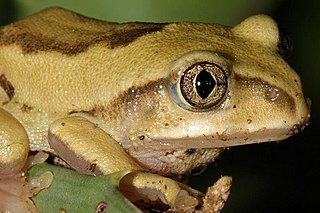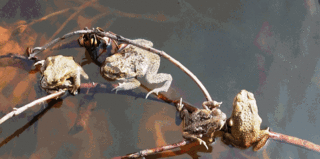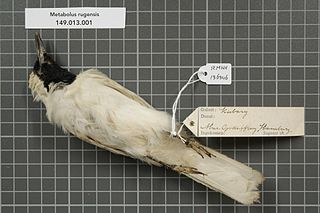Rhinella nesiotes is a species of toad in the family Bufonidae that is endemic to Peru. Its natural habitats are subtropical or tropical moist lowland forests and subtropical or tropical moist montane forests. It is threatened by habitat loss.
Rhinella pygmaea is a species of toad in the family Bufonidae. It is endemic to Brazil. Its natural habitats are subtropical or tropical moist lowland forests, subtropical or tropical moist shrubland, freshwater marshes, intermittent freshwater marshes, rural gardens, urban areas, and ponds. It is threatened by habitat loss.

The fairy tree frog is a species of frog in the family Hylidae endemic to Mexico. Its natural habitats are subtropical or tropical moist lowland forests, subtropical or tropical moist montane forests, and rivers. It is threatened by habitat loss.

Dendropsophus microps, the Nova Friburgo tree frog, is a species of frog in the family Hylidae. It is believed to be endemic to the Atlantic Forest of southern Brazil, but may occur in Argentina as well.
The Salta tree frog is a species of frog in the family Hylidae found in Argentina and Bolivia. Its natural habitats are subtropical or tropical dry forests, subtropical or tropical moist lowland forests, subtropical or tropical moist montane forests, rivers, freshwater marshes, and intermittent freshwater marshes. It is threatened by habitat loss.
The northern New Guinea tree frog is a species of frog in the subfamily Pelodryadinae. It is endemic to the Bird's Tail Peninsula. Its natural habitats are subtropical or tropical moist lowland forests and subtropical or tropical moist montane forests. It is threatened by habitat loss.

Spencer's river tree frog, also known as Spencer's tree frog or spotted tree frog, is a species of frog in the subfamily Pelodryadinae.
Rueppel's big-eyed tree frog is a species of frog in the subfamily Pelodryadinae. It is endemic to Indonesia. Its natural habitats are subtropical or tropical moist lowland forests, subtropical or tropical moist montane forests, and rivers. It is threatened by habitat loss.

Leptopelis mossambicus, the brown-backed tree frog, Mozambique tree frog or Mossambique forest treefrog, is a species of frog in the family Arthroleptidae found in Eswatini, Malawi, Mozambique, South Africa, Zimbabwe, and possibly Botswana. Its natural habitats are dry savanna, moist savanna, subtropical or tropical moist shrubland, subtropical or tropical dry lowland grasslands, subtropical or tropical seasonally wet or flooded lowland grasslands, swamps, freshwater marshes, and intermittent freshwater marshes. It is threatened by habitat loss.
The common forest tree frog is a species of frog in the family Arthroleptidae found in Angola, Cameroon, the Republic of the Congo, the Democratic Republic of the Congo, Equatorial Guinea, Gabon, Nigeria, and possibly the Central African Republic. Its natural habitats are subtropical or tropical moist lowland forest, subtropical or tropical moist montane forest, subtropical or tropical high-altitude grassland, rivers, intermittent freshwater marshes, and heavily degraded former forests.

The Uluguru forest tree frog or ruby-eyed tree frog is a species of frog in the family Arthroleptidae endemic to Tanzania. Its natural habitats are subtropical or tropical moist lowland forest, subtropical or tropical moist montane forest, rivers, and intermittent freshwater marshes. It is threatened by habitat loss.

The Antilles coqui, commonly known as the Montserrat whistling frog, Barbados whistling frog, or the Lesser Antillean whistling frog, is a species of frog in the family Eleutherodactylidae found in Bermuda, the Caribbean and northern South America. Its natural habitats are subtropical or tropical moist lowland forest, subtropical or tropical moist montane forest, subtropical or tropical moist shrubland, subtropical or tropical dry lowland grassland, arable land, pastureland, plantations, rural gardens, urban areas, and heavily degraded former forests.

Platypelis pollicaris, or common giant tree frog, is a species of frog in the family Microhylidae. It is endemic to northern and eastern Madagascar. Its natural habitats are subtropical or tropical moist lowland forests, subtropical or tropical moist montane forests, plantations, and heavily degraded former forest. It is threatened by habitat loss.

The Mindoro tree frog is a species of frog in the family Rhacophoridae. It is endemic to the Philippines.

The Ecuadorian cacique is a species of bird in the family Icteridae. It is found in Colombia, Ecuador, and Peru, where its natural habitat is subtropical or tropical moist lowland forest. A fairly common bird with a wide range, the IUCN has rated it a "species of least concern".

The many-colored bushshrike or many-coloured bushshrike is a species of bird in the bushshrike family, Malaconotidae.

The Chuuk monarch, or Truk monarch, is a species of bird in the family Monarchidae. It is monotypic within the genus Metabolus. It is endemic to the island of Chuuk in Micronesia.
Cecropia maxima is a species of plant in the family Urticaceae. It is endemic to Ecuador. Its natural habitat is subtropical or tropical moist montane forests. It is threatened by habitat loss.
Cecropia velutinella is a species of plant in the family Urticaceae. It is endemic to Ecuador. Its natural habitat is subtropical or tropical moist montane forests. It is threatened by habitat loss.
Guzmania ecuadorensis is a species of plant in the family Bromeliaceae. It is endemic to Ecuador. Its natural habitats are subtropical or tropical moist montane forests and subtropical or tropical high-altitude shrubland. It is threatened by habitat loss.












